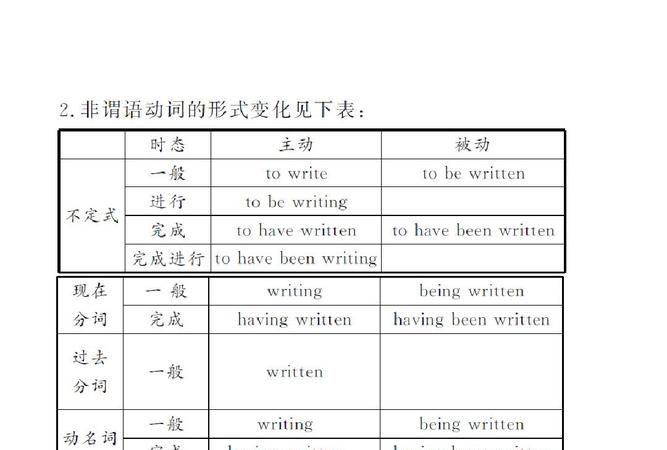本文目录
英语中的非谓语动词是什么
在句子中不是谓语的动词叫做非谓语动词
是动词的非谓语形式.动词一般在句子中充当谓语.在句中可起名词,形容词,副词的作用,在句中充当主语,宾语,表语,补语,定语或状语.即动词的非谓语形式除了不能独立作谓语外,可以承担句子的任何成分
3种形式:不定式,分词(现在分词、过去分词),动名词
1.非谓语动词与谓语动词的相同点有:
(1)如果是及物动词都可与宾语连用,例如:
They built a garden.
They suggested building a garden.
(2)都可以被状语修饰:
The suit fits him very well.
The suit used to fit him very well.
(3)都有主动与被动, “体”式(一般式;进行式;完成式)的变化。例如:
He was punished by his parents.(谓语动词被动语态)
He avoided being punished by his parents.(动名词的被动式)
We have written the composition.(谓语动词的完成时)
Having written the composition, we handed it in.(现在分词的完成式)
(4)都可以有逻辑主语
They started the work at once.(谓语动词的逻辑主语)
The boss ordered them to start the work.(动词不定式的逻辑主语)
We are League members.(谓语动词的主语)
We being League member, the work was well done.
(现在分词的逻辑主语)
2、非谓语动词与谓语动词的不同点有:
(1)非谓语动词可以有名词作用(如动词不定式和动名词),在句中做主语、宾语、表语。
(2)非谓语动词可以有形容词作用(如动词不定式和分词),在句中做定语、表语或宾语补足语。
(3)非谓语动词可以有副词作用(如动词不定式和分词),在句中作状语。
(4)谓语动词在句中作谓语,受主语的人称和数的限制;非谓语动词在句中不能单独作谓语,它不受主语的人称和数的限制。

非谓语动词语法讲解
非谓语动词的语法知识点详解
在句子中充当除谓语以外的句子成分的动词形式叫作非谓语动词。非谓语动词分为三种形式∶动名词,不定式和分词﹙包括现在分词和过去分词﹚
非谓语动词与其他动词的不同点:
1.非谓语动词可以有名词作用(如动词不定式和动名词),在句中做主语、宾语、表语。
2.非谓语动词可以有形容词作用(如动词不定式和分词),在句中做定语、表语或宾语补足语。
3.非谓语动词可以有副词作用(如动词不定式和分词),在句中作状语。
4.谓语动词在句中作谓语,受主语的人称和数的限制;非谓语动词在句中不能单独作谓语,它不受主语的人称和数的限制。
(5)英语中不能单独做句子的谓语。
非谓语动词分类:
不定式、动名词和分词作表语的区别
不定式作表语一般表示具体动作,特别是表示将来的动作。
不定式和动名词作宾语的区别
begin开始 determine决定 manage设法 agree同意 love 喜欢 fail不能 plan计划
(2)有少数动词只能用动名词作宾语
acknowledge承认,admit 承认 dislike不喜欢,讨厌 advocate:提倡,主张 complete完成
appreciate 感激,欣赏 avoid避免 enjoy享有,喜爱 delay延迟 escape逃跑,逃避 deny否认
consider 考虑 fancy幻想,爱好 mind 介意 miss错过 finish完成,结束不得 resist抵抗,阻止 imagine设想 postpone延迟,延期 practise 实行,实践 suggest建议 prevent阻止
keep保持 quit放弃停止 loathe非常讨厌,厌恶 recall回想
不定式和动名词作主语的区别
(1)动名词作主语时,通常用以表示一件已知的事或经验。不定式短语通常用来表示一件未完成的事或目的。例如:
Driving a car during the rush hour is tiring.在高峰时刻开车令人厌烦。
(2)不定式做主语,一般用it当形式主语,把作主语的不定式短语后置。例如:
It took me only five minutes to finish the job.
不定式、现在分词和过去分词作定语的区别
The child standing over there is my brother.站在那儿的男孩子是我弟弟。
不定式和分词作状语的区别
1)现在分词作状语时,现在分词的动作就是句子主语的动作,它们之间的关系是主动关系。
2)过去分词作状语时,过去分词表示的动作是句子主语承受的动作,它们之间的关系是被动关系。
Given more attention, the trees could have grown better.
非谓语动词常考的其它结构
(1)疑问词+不定式结构
疑问词who,what,which,when,where和how后加不定式可构成一种特殊的不定式短语。它在句中可以用作主语、宾语、表语和双重宾语。
(2)不带to的不定式
在表示生理感觉的动词后的不定式不带to。
这类词有: feel 觉得 observe 注意到,看到 overhear听到 watch注视 listen to听 perceive察觉,感知 notice注意 see看见 look at看 hear听

高中英语非谓语动词语法讲解
高中英语合集百度网盘下载
链接:***/s/1znmI8mJTas01m1m03zCRfQ
提取码:1234
简介:高中英语优质资料下载,包括:试题试卷、课件、教材、视频、各大名师网校合集。

非谓语动词独立主格结构讲解
英语有有能力考试B级(PRCTO-B)关于非谓语动词考点:
非谓语动词
非谓语动词
三大类:
分词
动名词
动词不定式
I.分词
分词分为现在分词和过去分词。
现在分词即v.-ing;可以be连用形成现在进行时态
过去分词即v.-ed;可以have,has连用形成现在完成时;还可以与be连用形成被动语态
含义:
现在分词v.-ing表示正在进行的、主动的
过去分词v.-ed
表示已经完成的、被动的
用法:
(1)作形容词,修饰名词
the
changing
world
the
changed
world
e.g.:
the
rising/risen
sun
the
developing/developed
country
the
man
standing
there
站在那里的人
the
work
finished
yesterday
昨天完成的工作
也可以写成the
man
who
is
standing
there
和the
work
which
was
finished
yesterday
(2)作副词,修饰句子
Seeing
the
tiger,
the
boy
cried.
Seen
from
the
hill,
the
city
is
small.
一般题型:是放在句子开头,然后判断所填动词跟后面主句的主语是主动还是被动关系。主动用现在分词v.-ing;被动用过去分词v.-ed
II.动名词
含义:即doing。当作名词使用;强调一种状态
用法:
(1)接某些动词后面
keep
/
avoid
/
need
/
like
/
enjoy
/
finish
/
mind
+
doing
e.g.:
Would
you
mind
opening
the
window?
(2)充当名词单独使用
Playing
football
is
my
hobby.
My
hobby
is
playing
football.
(3)介词后面用动名词doing
He
left
without
____(say)
goodbye.
I’m
interested
in
_____(read)
books.
III.动词不定式
含义:即to
do。表示为了……;强调一种目的
用法:
(1)接某些动词后面
fail
/
decide
/
want
/
have
/
happen
/
plan
/
manage/
pretend/
promise/
afford
+
to
do
(2)作形容词
I
have
many
things
to
do.
He
have
no
room
to
live
in.
(不及物动词需补全介词)
There
is
nothing
to
worry
about.
We
have
a
child
to
take
care
of.
(3)作副词修饰句子
They
went
to
Shanghai
to
visit
The
World
Expo.
他们去上海参观世博会了。
To
save
the
boy,
he
lost
his
life.
为了救那个男孩,他牺牲了。
这时可在前面加in
order或者so
as表示强调。
即in
order
to
do,
so
as
to
do
(4)作名词
To
eat
is
to
live,
but
to
live
is
not
to
eat.
When
to
start
is
not
known.
作主语时如果不定式过长,可放到后面,前面用形式主语it代替。
e.g.:
To
talk
with
the
superstar
is
not
easy.
=It
is
not
easy
to
talk
with
the
superstar
.
即我们常见的It
is
+
adj.
+
to
do;
注意如果前面有
I
think/make
/find
时,后面的is可省略。如
He
made
it
easy
to
learn
English.
(5)作宾语补足语
ask
tell
expect
期望
teach
sb.(某人)
+
to
do
allow
容许
remind
提醒
encourage
鼓励
invite
如:He
told
us
not
to
close
the
door.
注:1.考试经常考这些结构的被动语态:
be
asked
/
told/
expected
/
taught
/allowed
+
to
do
2.有些动词to
可省略,如:
make
/
have
/
let
sb.
do
让某人做……
help
/
hear
/
see
sb.
do
但这些结构换成被动语态,to就需还原:
如
I
saw
him
get
on
the
bus.
→He
was
seen
to
get
on
the
bus.

以上就是关于英语非谓语动词精讲,英语中的非谓语动词是什么的全部内容,以及英语非谓语动词精讲 的相关内容,希望能够帮到您。
